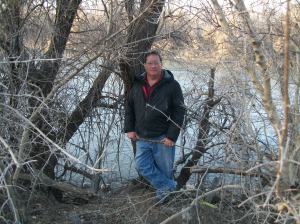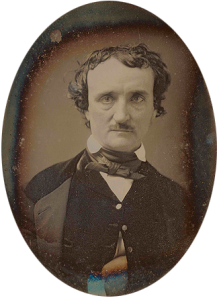
Some writers have interesting habits.
I have always found one of the most interesting aspects of studying the lives of famous writers to be the personal habits they have while writing. The habits show the writer’s personal side and perhaps give an insight into how their creativity is ingrained in their natures. Following are some examples of the better known habits of mainstream authors (the few examples I have collected of “horror habits” follow these).
Hemingway said that he, at least in his Paris years, wrote for four hours each day before going to work at the Kansas City Star office, he wrote using pencils and a spiral bound notebook, and he started each days writing by sharpening twenty pencis.
F. Scott Fitzgerald never rewrote anything less than nine times.
Thomas Mann was very disciplined and rose and dressed in a suit each day as if he were going to work at a bank (even though he was going only so far as his living room), started each day at the same time (I think 8:00 a.m.), wrote for four hours, broke for lunch for an hour, wrote for another four hours, and then ended his day, by going back to his bedroom and taking off his suit.
Hunter Thompson and Henry Miller were at the opposite end of the discipline scale and might write for days, then not write again for days or weeks, before going on another binge of writing. Thompson might write some lines on a napkin while having lunch at a restaurant, then take the napkin and force it through a fax to get the work to his editors at Rolling Stone.
Here are the tidbits on writing habits by authors of horror.
Thomas Cotterill, another WordPress member, wrote this interesting article on the habits of Stephen King. I have read elsewhere that Stephen King normally writes a first draft, which he runs past his wife, Tabitha, makes some changes and then sends it out to friends for their inputs, and then writes a final draft, which he sends to the publisher.
I have yet to find anything detailed about Poe’s habits, but I did find this general description on the website of the Edgar Allan Poe Society of Baltimore.
“Edgar A. Poe, one of the Editors of the Broadway Journal. He never rests. There is a small steam-engine in his brain, which not only sets the cerebral mass in motion, but keeps the owner in hot water. His face is a fine one, and well gifted with intellectual beauty. Ideality, with the power of analysis, is shown in his very broad, high and massive forehead — a forehead which would have delighted Gall beyond measure. He would have have [[sic]] made a capital lawyer — not a very good advocate, perhaps, but a famous unraveller of all subtleties. He can thread his way through a labyrinth of absurdities, and pick out the sound thread of sense from the tangled skein with which it is connected. He means to be candid, and labours under the strange hallucination that he is so; but he has strong prejudices, and, without the least intention of irreverence, would wage war with the Deity, if the divine canons militated against his notions. His sarcasm is subtle and searching. He can do nothing in the common way; and buttons his coat after a fashion peculiarly his own. If we ever caught him doing a thing like any body else, or found him reading a book any other way than upside down, we should implore his friends to send for a straitjacket, and a Bedlam doctor. He were mad, then, to a certtainty.” — (Thomas Dunn English, “Notes About Men of Note,” The Aristidean, April 1845, p. 153. At this time, Poe and English were still friends, and the tone of this item is happy and jocular. In reviewing this issue of the Aristidean in his own Broadway Journal, for May 3, 1845, Poe comments “. . . the ‘Notes about Men of Note’ are amusing” (BJ, 1845, p. 285, col. 1).)
Dean Koontz says this about his own writing habits on his website:
“I work 10- and 11-hour days because in long sessions I fall away more completely into story and characters than I would in, say, a six-hour day. On good days, I might wind up with five or six pages of finished work; on bad days, a third of a page. Even five or six is not a high rate of production for a 10- or 11-hour day, but there are more good days than bad. And the secret is doing it day after day, committing to it and avoiding distractions. A month–perhaps 22 to 25 work days–goes by and, as a slow drip of water can fill a huge cauldron in a month, so you discover that you have 75 polished pages. The process is slow, but that’s a good thing. Because I don’t do a quick first draft and then revise it, I have plenty of time to let the subconscious work; therefore, I am led to surprise after surprise that enriches story and deepens character. I have a low boredom threshold, and in part I suspect I fell into this method of working in order to keep myself mystified about the direction of the piece–and therefore entertained. A very long novel, like FROM THE CORNER OF HIS EYE can take a year. A book like THE GOOD GUY, six months.”
Here is an interesting interview by M.R. Hunter with Richard Matheson in Lastheplace.com. Apparently, Mr. Matheson does not have a computer, but writes everything in longhand and then has it typed up.
I have yet to find anything on Lovecraft’s writing habits, but here is a link to HPLovecraft.com that details his personal interests including his unusual dietary habits.
Lord Dunsany had the most eccentric habits of which I have heard. The Wikipedia article on Lord Dunsany states:
“Dunsany’s writing habits were considered peculiar by some. Lady Beatrice said that “He always sat on a crumpled old hat while composing his tales.” (The hat was eventually stolen by a visitor to Dunsany Castle.) Dunsany almost never rewrote anything; everything he ever published was a first draft.[7] Much of his work was penned with quill pens, which he made himself; Lady Beatrice was usually the first to see the writings, and would help type them. It has been said that Lord Dunsany would sometimes conceive stories while hunting, and would return to the Castle and draw in his family and servants to re-enact his visions before he set them on paper.[citation needed]”
If you know of a source for information on the work habits of one or more horror writers, please share it. If you are searching for a topic of an article to write, I would like to suggest writing on the work habits (or interests) of horror writers. It would be fascinating to see if there is a common thread among them or if they vary from the habits of mainstream authors. For example, I have found out that Algernon Blackwood, Arthur Machen, and Bram Stoker were members of the Hermetic Order of the Golden Dawn.
Anyway, I am now officially rambling.
If you have any thoughts or comments on this article, please share them.






